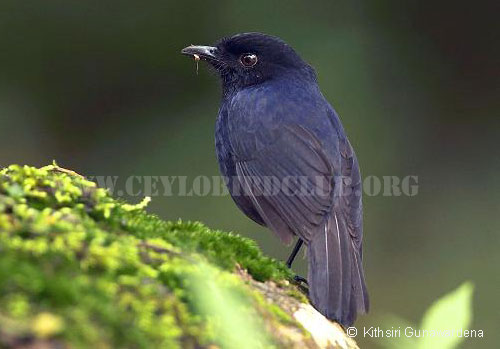


Ceylon Whistling Thrush Myophonus blighi
(Ceylon Arrenga, Sri Lanka Whistling Thrush)
Sinhalese - Arangaya
Tamil - No Tamil names recorded

The Ceylon Whistling Thrush has a very restricted range being confined to the wet montane forests over 680 metres. It is considered an endangered species. This is one of the most difficult to observe of all Sri Lankan birds. Often, the usual encounter one has with the Whistling Thrush is hearing its high sibilant call sree, or sree-reee which carries over the noise of the torrential streams running though dense montane forests which it inhabits. As the bird is usually active during dawn and dusk, even if one is fortunate enough to see the bird it would only be a glimpse of a dark shape flitting in and out of the foliage on to a rocky stream.
However, there are instances where birds have been seen in a locality for a limited period of time coming to the open during day time to feed, affording rare opportunity to a handful of fortunate bird watchers.
Although it has been recorded around 680 metres elevation it prefers much higher altitudes. The Horton Plains, the Peak Wilderness and the Knuckles Range are favoured sites. The ‘Arrenga Pool’ on the way to the Horton Plains is a favourite site, while others have been observed at a number of locations in and around Nuwera Eliya. In July 2007 some members of the Ceylon Bird Club saw or heard at least 15 birds along a path in the Peak Wilderness.
The Ceylon Whistling Thrush lives in pairs. Unlike most other Whistling Thrushes of the region, in our species the sexes are dissimilar. The male is black with a blue sheen on the back, scapulars and breast while the female is darkish earth brown above and paler, brighter rufous-brown below. Both have a small, bright blue shoulder patch. Young birds resemble the female but have indistinct vertical, paler streaking on the underparts.
Their favourite habitat is dense cover close to torrential montane streams. From this cover, birds emerge every now and then to feed amongst the rocks. Almost always, their arrival is heralded by a high, sibilant Sree-ee or sree-reee call which easily carries over the roar of the cascading water. The female appears to be shyer than the male. They both have a habit of fanning the tail feathers frequently. They feed on insect matter, freshwater crabs, frogs, geckoes etc. It is most probable that they feed on vegetable matter as well. The call is uttered by both sexes but the male has a beautiful, sustained, well modulated, high pitched song which it utters from a prominent rock or bough near or standing in water. Although its tail is held down, the singing bird’s stance is reminiscent of that of a singing Magpie Robin, the beak opening and closing in a very similar manner.
According to W.W.A Phillips, a founder member of the Ceylon Bird Club, the ‘Arrenga’ has a very restricted nesting season, being confined mostly to the month of April. According to him this, along with the fact that it often lays only one or at most two eggs, may account to its extreme rarity.
Phillips in his notes on the ‘Nests and Eggs of Ceylon Birds’ in the ‘Ceylon Journal of Science’, says the nest is often placed near running water, the birds tending to use the same locality year after year if undisturbed. The nest is a rather large, deep cup in the centre of a compact but untidy looking mass of green moss along with a few decayed leaves and ferns. The eggs are rather broad ovals, distinctly pointed at the smaller end. The ground colour is pale stone or yellowish green, on which are a few faint, light, reddish brown stains, streaks or freckles around the large end.
Both he and G.M Henry, another founder member of the Ceylon Bird Club are of the view that nests are more easily located than the bird itself, though, according to the latter not necessarily accessible.